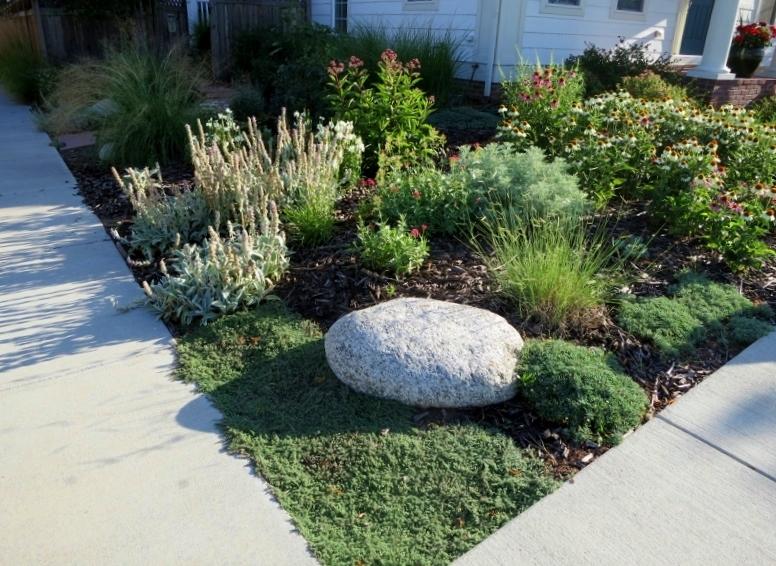We thought you'd like see some of this year's residential Habitat Hero gardens. Unlike the public parks and trails, these gardens are private, so over the next few blog posts we'll give you a virtual "tour." They're full of ideas to inspire your own wildscapes and habitat gardens!
Here are the first three "Outstanding" and "Special Recognition" yards (listed in alphabetical order, no ranking implied):
Alberty/Buschmann Yard, Salt Lake City, UT
This Salt Lake City couple thought their steep back slope, which adjoins City-owned Open Space, was natural until 2010 when they learned from a county awareness campaign that a carpet of invasive and toxic myrtle spurge had choked out all the native plants.
Within days, these energetic restoration gardeners had pulled a "whole carload" of myrtle spurge, leaving them with a bare slope and a "mudslide to be" looming over their house.
What could they plant that would survive on a hot, west-facing slope with thin soil covering rocks? In order to save water and not introduce the next invader, they chose plants native to the Intermountain West, and created a beautiful naturalistic habitat garden.
Not all of the 200 plants they plugged into the slope to stabilize it survived. But some natives--including big sagebrush and rubber rabbitbrush--volunteered once the toxic spurge was cleared away, and over four years they've established other native shrubs, including mountain mahogany, Gambel oak, and serviceberry, plus bunch grasses and wildflowers.
The unexpected benefit: A "huge burst of wildlife," including hummingbirds they hadn't seen before, a host of insect pollinators, and baby owls that grew up in the yard. "Our daughter is growing up with a community in her backyard, not just a mess of weeds dribbling caustic sap."
Bidgood Garden, Denver, CO
When this Denver homeowner moved with his family into their new house in a city infill development in 2009, the front-yard landscaping included foundation plantings and Kentucky bluegrass turf.
The turf at the front corner was hard to maintain, so in 2012, the homeowner decided to replace it with a perennial garden that would build on the existing foundation plantings. He smothered the turf with compost and manure topped with black plastic, and then rototilled the dead grass into the soil and began to plant.
He selected plants adapted to the former prairie site with flowers and foliage in tones of white, pink and silver, in part so the garden would look good at night and would attract night-flying pollinators, including white-lined sphinx moths. He also used the runoff from his roof for supplemental water to maintain a few mesic prairie plants, including Joe Pyeweed, a butterfly magnet.
The resultant 300-square-foot patch of city habitat is not only aesthetically pleasing and water-saving, it buzzes with pollinators and hummingbirds. The homeowner now photographs bumblebees for the Xerces Society's Bumblebee Watch project, and he and his kids contribute ladybug observations to Cornell University's "Lost Ladybug" project.
Cappel Yard, Brighton, CO
When this couple moved to a subdivision in semi-rural Brighton, they knew they wanted a garden that would attract wildlife rather than just an expansive area of turf grass lawn. They also wanted to maintain an aesthetically pleasing yard and not violate their subdivision watering and lawn regulations.
They started with a single pre-planned garden from High Country Gardens, and over the years added more plants from High Country Gardens, Harlequin's Gardens in Boulder, and the Center for ReSource Conservation's Garden-in-a-Box program.
These intrepid gardeners learned by trial and error, through "drought, hail and even a grasshopper plague."
Now they point with pride to the diversity of wildlife that come through their garden, from songbirds and pollinators to praying mantids, cottontail rabbits, toads, and hognose and bull snakes (both of which are great for keeping the rodent population in balance). "Our garden is our favorite place to be!"
Congratulations to all of the 2014 Habitat Hero Gardens. Thank you for helping us make the places we live, work and play welcoming to wildlife, especially to pollinators and songbirds, for saving water, and for mitigating the effects of climate change. You are truly heroes!
Join Audubon Rockies, Plant Select® and High Country Gardens in promoting wildscaping. Be a Habitat Hero.
By Habitat Hero
Stay in the Know
Sign up for emails to stay up to date on how you can help and enjoy birds in Colorado, Wyoming, and Utah.





